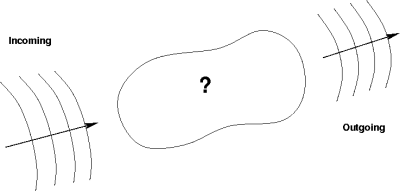These notes are based on Gunther Uhlmann’s lectures for MATH 581 taught at the University of Washington in Autumn 2009.
An index to all of the notes is available here.
This course is about solving inverse problems. What are inverse problems? It is difficult to define them precisely, let’s just say “I’ll know one when I see one”, but we can give a rough idea.
We have a medium we’re trying to understand — say a patient’s internal organs — and we probe it with waves as in this figure:

We can measure the outgoing waves. Then the “inverse problem” is this:
Problem 1 (General Inverse Problem) Can you recover the internal parameters of the medium by measuring outside the medium its response to incident waves?
Remember that none of these terms are defined precisely. What is a wave?
1. 1st Quarter
In this quarter we will consider the case when waves are X-rays that we can send in different directions and measure the attenuation in intensity as the x-rays pass through the medium. X-rays are high energy electromagnetic waves that travel (almost) in a straight line through media like human tissue. This is the mathematical setup behind the CT scan.

Continue reading →
, in
this is just the set of lines, as we discussed before. We parameterize this set by
, the distance of the hyperplane from the origin, and
, the unit normal vector to the hyperplane:

